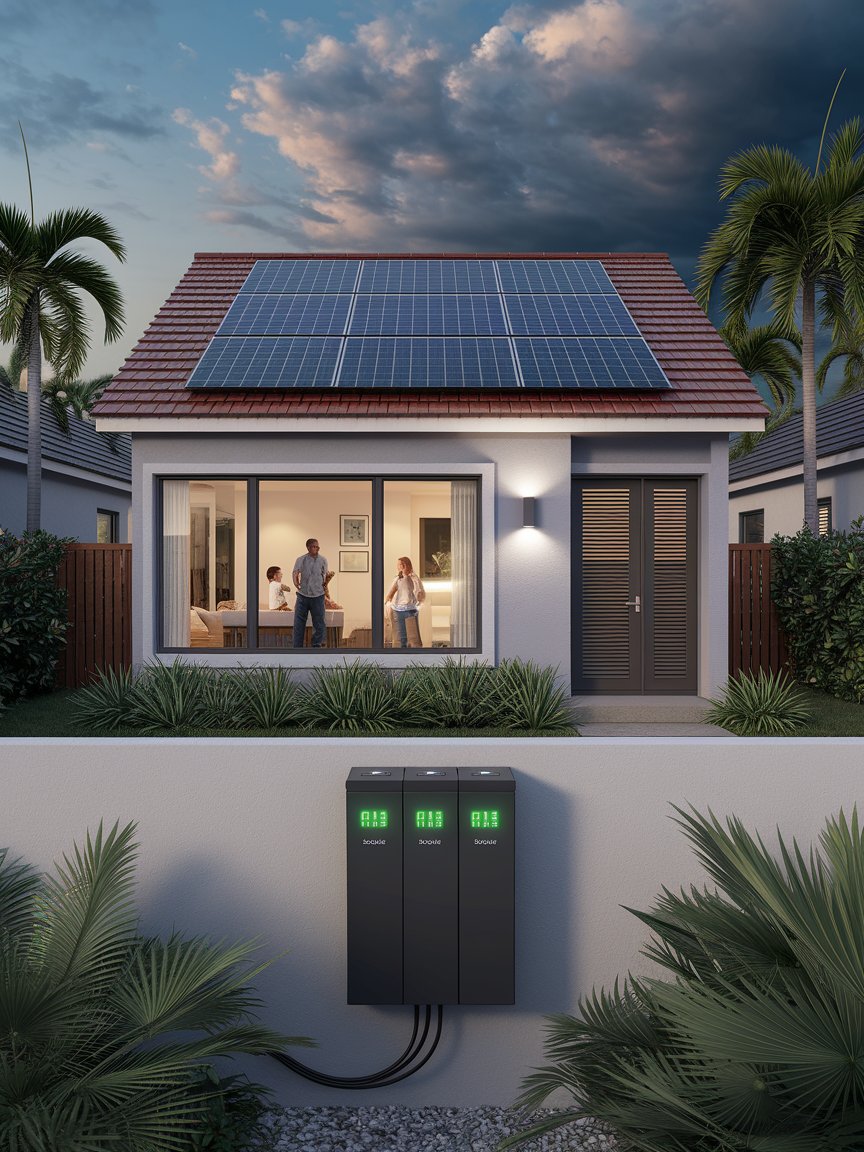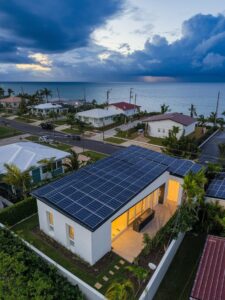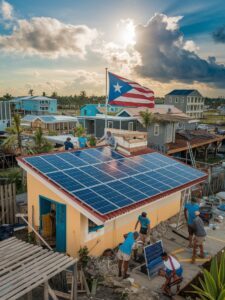
Puerto Rico’s vulnerability to natural disasters has been starkly demonstrated over the past decade. From Hurricane María in 2017 to the series of earthquakes in 2020 and Hurricane Fiona in 2022, the island has faced repeated challenges that exposed critical weaknesses in its infrastructure—particularly its electrical grid. During these emergencies, communities experienced power outages lasting weeks or even months, creating cascading crises in healthcare, food security, and communications. Conventional emergency preparedness strategies relied heavily on diesel generators, which proved problematic due to fuel shortages, mechanical failures, and hazardous operating conditions. As climate scientists predict increasingly severe and frequent storms for the Caribbean region, Puerto Ricans are seeking more reliable solutions for disaster readiness. Solar energy systems with battery storage have emerged as a game-changing option, offering households the ability to maintain essential power regardless of grid conditions. Green Power Solar Systems has pioneered residential solar solutions specifically designed for emergency resilience across Puerto Rico’s diverse communities. This blog explores why solar power has become a critical component of comprehensive disaster preparedness for Puerto Rican homes, examining both the immediate benefits during emergencies and the everyday advantages that make these systems practical investments in household security and peace of mind.
H2 Section 1: Learning from History: Puerto Rico’s Power Vulnerabilities (2 paragraphs, 145 words)
Learning from History: Puerto Rico’s Power Vulnerabilities
The devastation of Hurricane María revealed fundamental vulnerabilities in Puerto Rico’s centralized electrical infrastructure. The storm damaged or destroyed approximately 80% of the island’s transmission and distribution network, resulting in the second-longest blackout in world history. Repair efforts were hampered by the island’s topography, with difficult-to-access mountain regions remaining without power for nearly a year. This extended power loss contributed to an estimated 2,975 excess deaths in the months following the hurricane, many resulting from inability to refrigerate medications, operate medical devices, or access timely healthcare.
Following María, significant investments were made to strengthen the main grid, yet subsequent events have demonstrated continuing vulnerabilities. The 2020 earthquake sequence caused the temporary shutdown of the Costa Sur power plant, which generated approximately 25% of the island’s electricity, triggering widespread outages. More recently, Hurricane Fiona in 2022 again plunged much of the island into darkness despite post-María grid improvements. These recurring failures underscore the limitations of centralized infrastructure in the face of Puerto Rico’s unique geographical and climatic challenges.
H2 Section 2: Beyond Generators: The Solar Alternative for Emergency Power (3 paragraphs, 210 words)
Beyond Generators: The Solar Alternative for Emergency Power
For decades, diesel generators represented the standard backup power solution for Puerto Rican homes. However, the extended outages following recent disasters exposed critical limitations of generator dependency. During Hurricane María’s aftermath, fuel shortages became acute as damaged ports and roads disrupted supply chains, leaving many generator owners unable to operate their equipment despite significant investment. Those who secured fuel faced additional challenges: the constant noise disrupted already stressed communities, exhaust fumes created health hazards when generators were placed near living spaces, and mechanical failures were common with continuous operation—particularly for residential units not designed for extended use.
Solar energy systems with battery storage offer a compelling alternative that addresses these limitations. Once installed, these systems harvest renewable energy daily, eliminating dependency on fuel deliveries during emergencies when transportation infrastructure may be compromised. Modern lithium-ion batteries store this energy efficiently, allowing households to power essential loads during nighttime or cloudy conditions. The systems operate silently, produce no emissions, and require minimal maintenance compared to generators. Green Power Solar Systems’ residential installations include weather-resistant mounting systems designed to withstand hurricane-force winds, with panels rated to endure the impact of small debris.
Perhaps most significantly, solar + storage systems provide power independence during normal operations as well as emergencies. While generators remain idle until outages occur, solar systems work daily to reduce electricity bills, effectively providing financial returns that offset their initial cost. This dual-purpose functionality transforms emergency preparedness from a sunk cost to an investment with ongoing benefits, making comprehensive readiness financially accessible to more Puerto Rican families.
H2 Section 3: Designing a Resilient Home Solar System (2 paragraphs, 150 words)
Designing a Resilient Home Solar System
Creating a truly resilient home solar system requires thoughtful design that balances everyday efficiency with emergency capacity. Green Power Solar Systems utilizes a specialized assessment process that begins by identifying a household’s critical loads—essential equipment that must remain operational during emergencies. This typically includes refrigeration for food and medicine, lighting for key areas, communications equipment, medical devices, and often a small cooling solution for at least one room that can serve as a heat relief area. These critical loads are then isolated on designated circuits that can be powered exclusively by the solar + storage system when the grid is down.
System sizing follows a more conservative approach for emergency-focused installations compared to standard solar design. While typical grid-tied systems might be sized primarily for economic optimization, resilience-focused systems incorporate additional capacity to account for extended periods of suboptimal weather conditions. Battery storage is particularly crucial, with Green Power Solar Systems recommending a minimum of 10 kilowatt-hours of usable storage capacity for modest homes and scaling upward based on critical load requirements and household size. This conservative approach ensures reliable performance even during extended emergency situations.
H3 Subsection: Case Study – The Rodríguez Family in Humacao (3 paragraphs, 215 words)
Case Study: The Rodríguez Family in Humacao
The Rodríguez family’s experience in the coastal municipality of Humacao illustrates the life-changing impact of solar preparedness. Their neighborhood was among the first to feel Hurricane María’s full force as it made landfall in 2017, and among the last to have grid power restored nearly ten months later. During this extended outage, the family relied on a small portable generator that provided just four hours of limited power daily due to fuel rationing. The situation became especially critical for their teenage daughter, whose asthma required electric nebulizer treatments during severe episodes—leading to several emergency evacuations when generator fuel was unavailable.
In 2019, the family invested in a comprehensive solar + storage system installed by Green Power Solar Systems. The installation includes 5.2 kilowatts of rooftop solar paired with 13.5 kilowatt-hours of battery storage. The system powers their entire home during normal operation, while a carefully designed critical load panel ensures essential systems—including their daughter’s medical equipment—remain operational indefinitely during outages. The battery capacity provides approximately three days of backup for these critical systems without any solar production, though in typical conditions, daily solar generation recharges the batteries even during cloudy weather.
When Hurricane Fiona struck in September 2022, the Rodríguez family experienced the system’s value firsthand. While their neighborhood again lost grid power for three weeks, their home maintained continuous electricity for critical needs. More importantly, they were able to assist neighbors by providing a charging station for communication devices and storing community medications requiring refrigeration. What began as a personal emergency preparedness measure evolved into a neighborhood resilience asset, demonstrating how distributed solar can strengthen community bonds during crisis situations.
H2 Section 4: Economic Aspects of Solar Emergency Preparedness (2 paragraphs, 145 words)
Economic Aspects of Solar Emergency Preparedness
The financial case for solar emergency preparedness extends beyond the immediate resilience benefits. Puerto Rico’s electricity rates—currently averaging 29 cents per kilowatt-hour and among the highest in the United States—mean that solar systems deliver substantial savings during normal operations. Green Power Solar Systems’ clients typically report payback periods of 5-7 years based on electricity savings alone, after which the systems continue providing essentially free power for their 25+ year lifespan. When factoring in the avoided costs of emergency generator fuel, hotel stays during extended outages, spoiled food, and potential medical evacuations, the economic argument becomes even more compelling.
Multiple financial incentives further improve accessibility to these systems. The federal Investment Tax Credit currently provides a 30% reduction in system cost for qualifying taxpayers. Additionally, Puerto Rico offers local incentives including sales tax exemptions on equipment and property tax adjustments for homes with renewable energy systems. Green Power Solar Systems also provides financing options specifically designed for emergency preparedness systems, with monthly payments often lower than the electricity bill reduction, creating immediate positive cash flow while building long-term resilience.
H2 Section 5: Beyond Physical Preparation: The Psychological Security of Energy Independence (2 paragraphs, 140 words)
Beyond Physical Preparation: The Psychological Security of Energy Independence
The benefits of solar emergency preparedness extend beyond physical resilience into psychological well-being. Research conducted after Hurricane María documented the significant mental health impacts of extended power outages, including increased anxiety, depression, and post-traumatic stress symptoms. These effects were particularly pronounced for individuals responsible for vulnerable family members requiring electrical medical equipment. The uncertainty of when power might be restored created a persistent state of stress that compounded the physical challenges of disaster recovery.
Homeowners with resilient solar systems report significant reductions in pre-storm anxiety and post-disaster stress. Knowing that essential power will remain available regardless of grid conditions creates a sense of security that transforms the disaster preparation experience. Green Power Solar Systems regularly receives feedback from clients describing how their systems provide “peace of mind that’s worth more than the equipment itself.” This psychological benefit is particularly valuable in Puerto Rico’s current context, where each approaching storm season triggers collective anxiety based on recent historical experience.
H2 Section 6: Getting Started: Practical Steps Toward Solar Emergency Preparedness (2 paragraphs, 145 words)
Getting Started: Practical Steps Toward Solar Emergency Preparedness
For Puerto Rican homeowners considering solar for emergency preparedness, several practical steps can help develop an effective strategy. Begin by conducting a thorough assessment of your household’s critical power needs during emergencies. Create an inventory of essential devices, their power requirements, and operational priorities. This assessment should include medical equipment, refrigeration, water pumps for properties relying on wells, essential lighting, communications devices, and any cooling equipment needed for heat-sensitive individuals. Green Power Solar Systems provides free critical load calculators to help families identify their minimum power requirements during extended outages.
Next, evaluate your property’s solar potential, considering roof condition, orientation, shading factors, and available space for battery placement. Most Puerto Rican homes have excellent solar exposure, but structural considerations are particularly important for resilient systems designed to withstand hurricane conditions. Professional assessment is recommended to identify optimal panel placement for both energy production and wind resistance. For homes with limited roof space or structural concerns, ground-mounted systems offer an alternative that can be engineered for extreme wind conditions when properly anchored to concrete foundations.
Conclusion with call-to-action (70 words)
As Puerto Rico navigates an uncertain climate future, household emergency preparedness has evolved from prudent planning to essential protection. Solar energy systems offer a sustainable path to resilience that works daily while standing ready for emergencies. Green Power Solar Systems invites you to take the first step toward energy independence—contact us today for a free resilience assessment and discover how solar can transform your home into a beacon of security for your family and community.





No comment yet, add your voice below!